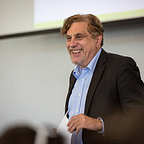Optimism: The Other Stimulus Schools Need to Reopen
Is it possible to be authentic and hopeful during hard times.
For the first time since the pandemic began a year ago, there seems to be an emerging sense of hope. Some metrics show positive signs: There have been more than 165 million vaccine doses administered in the United States, a steady decline of deaths nationwide since January, and a gradual reopening of some sectors of the economy.
In my conversations with educators and administrators around the country, however, I’ve found that whatever guarded optimism exists is eclipsed by the anger, frustration, and concern that they have felt since the start of the crisis. Young people were inundated with difficult news of illness, death, economic woes, and systemic racism, while others experienced first-hand grief, food scarcity, and trauma. In addition, the uneven nature of school reopenings and access to virtual education has led to some students becoming more isolated and falling behind much more than others. For educators, the anxiety of physically returning to their schools looms large.
Given these current realities, how can educators both carry the burdens of this past year and convey the optimism of the moment? How do we move forward without becoming stuck in despair, emotionally shut down, or Pollyannaish? We have to remember that the whole enterprise of learning and teaching with curiosity and joy is built upon a foundation of optimism and hope for the future. Just like an economic stimulus boosts a struggling economy, a sense of optimism and hope can be injected back into schools.
First and foremost, educators must be honest and authentic by acknowledging the shared humanity and hardships they share with their students. Conveying blind optimism will appear disingenuous to young people. Share the good and the bad. While it is true that institutions are fragile, and isolation is taxing, there are hopeful signs to look out for, too. We live in a time where we can stay in contact with the people we love, and where scientific advancements have led to developments of drugs and vaccines that dramatically increase people’s chance of survival.
Another step for educators and administrators to take is to create clear communication networks with other leaders. This not only builds up a sense of camaraderie and cohesion but also increases the psychological and emotional capacity of staff. Young people need to see strong networks of teachers, administrators, community leaders, and policymakers who work on their behalf and are mindful of the difficulties that they face.
Next, create a set of clear plans. Each classroom, program, and school should not hesitate to create a new vision grounded in the present conditions for the months to come, rather than waiting for guidance. A direction is crucial, despite the unknowns of future challenges and needs. Beyond keeping everyone safe, ask yourself and your team to identify the top three goals that you want to achieve for the rest of the school year, during the summer, and beyond. For example, I would recommend fostering a strong sense of belonging for adults and students, strengthening motivation for engaged learning, and linking to families and the community to handle the surge of mental health problems.
Finally, school communities must transmit a culture of optimism. At the core are positive relationships. Each person has a role to play in prioritizing positive relationships in whichever circles they inhabit-whether it’s in a classroom, an afterschool program, or an entire school. The creation of these “developmental spaces” allows for growth and a sense of future to flourish.
Under difficult circumstances, students tend to look to their guardians, teachers, and mentors for a sense of safety. Because children and younger adolescents are developmentally predisposed to live in the here-and-now rather than looking toward the future, it is vital for adults to hold a sense of purpose and a belief that things can get better. This is particularly important for students who have endured months of significant and unequally distributed hardship on themselves and their families. I’ll end by referring to findings from the Framingham Heart Study, which found that positive emotions are indeed contagious and can affect individuals up to three degrees of separation. The same can be done with hope. Each of us can make small changes to build towards a new future by listening, empathizing, and strengthening relationships. Only then will we be able to replenish the optimism young people lost this year.
—
A longer discussion on optimism during difficult times can be found in Dr. Noam’s book Ten Big Bets: Transforming Education During the Pandemic and Beyond.
Originally published at https://www.psychologytoday.com.
